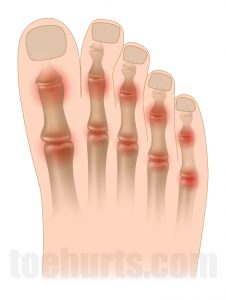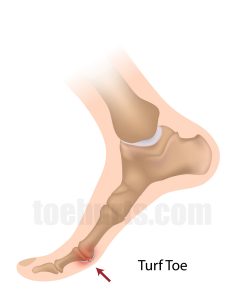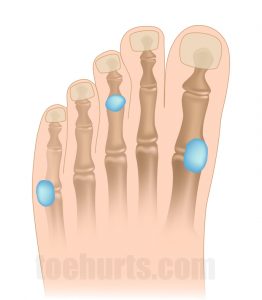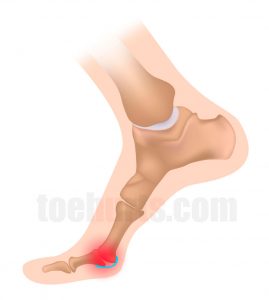 Arthritis is the medical term used to describe a cluster of conditions that affect around 20% of adults living in the United States. Specifically speaking, there are more than 100 different conditions and diseases that fall under the term “arthritis”; many of these affect joints in the knees, feet, and toes. Here are some of the most common arthritic conditions that affect these joints:
Arthritis is the medical term used to describe a cluster of conditions that affect around 20% of adults living in the United States. Specifically speaking, there are more than 100 different conditions and diseases that fall under the term “arthritis”; many of these affect joints in the knees, feet, and toes. Here are some of the most common arthritic conditions that affect these joints:
- Osteoarthritis
- Rheumatoid arthritis
- Juvenile arthritis
- Fibromyalgia
- Psoriatic arthritis
- Gout
- Lyme arthritis (or Lyme disease)
While the word “arthritis” comes from the Greek arthro- (joint) and –itis (inflammation), it is a common misconception that arthritis is synonymous with joint inflammation. In fact, one of the most common forms of arthritis in the foot and toes, osteoarthritis, is primarily characterized by stiffness and pain. Arthritis affects not only the joint itself, but also connective tissue and other tissues that surround the joint. The type of symptoms encountered depend to a great extent on which type of foot or toe arthritis the patient has. Below we will discuss a few of the most common forms of arthritis in the foot and toes and their possible causes, symptoms, and treatments.
Causes of Foot and Toe Arthritis
Do you have arthritis in the feet, arthritis in the toes, or arthritis in fingers? There are many different possible causes for these various forms of arthritis. Often, there is no one simple foot or toe arthritis cause, instead a number of factors will be involved. Genes, lifestyle, environment, diet, and age all play a role.
Genetic Factors
Osteoarthritis in toes can be caused by a gene defect – where the gene that is responsible for producing collagen fails, leading to weak joint cartilage. This may cause the onset of arthritis at an abnormally early age. Osteoarthritis is also age-related and usually runs in families.
Another genetic factor may cause rheumatoid arthritis; researchers are still working to draw stronger conclusions, but they have found that the genetic marker HLA coincides with a probability five times greater of developing rheumatoid arthritis in toes and elsewhere in the body.
Further Causes and Risk Factors
Other factors that increase one’s risk of arthritis include: obesity, joint injuries (e.g. dislocations, twists, sprains), bone fractures, impact sports, and jobs that put a lot of stress on the knee and joints of the foot (i.e. jobs that require you to kneel or squat for significant periods of time, or jobs that involve a lot of lifting).
When it comes to some forms of arthritis in the feet however, the causes may be completely different. What causes psoriatic arthritis in the feet? Psoriatic arthritis is in fact an autoimmune disease, and is linked to the dermatological condition, psoriasis. Psoriatic arthritis commonly affects the feet and toes, possibly making it painful to stand or walk. With fibromyalgia on the other hand, doctors have yet to pinpoint a specific cause; the condition is thought to stem from a malfunctioning of the patient’s central nervous system, whereby regular pain signals are “amplified”. Although this form of arthritis is less common, fibromyalgia can also cause arthritis of the feet.
Arthritis Symptoms
If you suspect that you may be suffering from arthritis pain, consult a specialist immediately. The most common arthritic symptoms are: inflammation of the joint, stiffness, pain, and limited movement of the foot joints. These symptoms are common to many conditions, including rheumatoid arthritis in toes, arthritis of the feet, psoriasis arthritis, and arthritis of the toe joint.
Symptoms: A few common conditions
Gout is a very common inflammatory arthritis condition that affects men much more than women. It often manifests itself as podraga (big toe arthritis). Foot gout is characterized by chronic attacks of arthritis in toes and arthritis in feet. The build-up of uric acid in the bloodstream eventually causes the typical arthritis in feet and toes symptoms of pain, inflammation, tenderness, and stiffness. (For more information on gout visit this page.)
Rheumatoid arthritis in toes and feet are particularly common conditions, due to the stress and wear that these joints undergo. Rheumatoid arthritis feet, rheumatoid arthritis ankle, rheumatoid arthritis knee, and rheumatoid arthritis toes often affect both the left and right side equally. Stiffness is often felt in the morning for over an hour, and after a while the joints in the feet may become deformed and/or lose their range of mobility. There may be other symptoms such as numbness and burning in the affected areas; additionally other conditions like corns, bunions, hammer toe, and claw toe may develop.
When pain in the foot and toe joints are a secondary cause of a disease, however, the symptoms can be quite different. Lyme disease, for example, is caused by bacteria, and early symptoms of sickness may include a temperature, headaches, tiredness, and a particular type of rash known as erythema migrans. If untreated, lyme disease arthritis will develop, causing pain and swelling in the knee, foot, toe, and other joints.
Psoriatic arthritis (or arthritis psoriatica) develops in about 30% of patients suffering from psoriasis. Its symptoms, in addition to the typical symptoms of inflammatory arthritis, include tendinitis, discolorations and other changes to the toe and finger nails, redness, and dactylitis (a sausage-like swelling of the psoriatic arthritis toes or fingers). Psoriatic arthritis joints may also be warm to the touch.
Arthritis Treatment & Prevention
Arthritis treatment options depend on exactly what type of arthritis one has – so whether you think you have a rheumatoid arthritis foot, a rheumatoid arthritis toe, arthritis toes, arthritis feet, or arthritis knees, it is always best to consult a medical professional to determine the best course of action. Treatment options range from rest, exercise, orthopedic bracing, and physical therapy, to medication and surgery.
For non-inflammatory forms of foot arthritis pain medication is often used, plus physical activity and weight control (if necessary). Inflammatory forms of foot and toe arthritis will require different medications, ranging from anti-inflammatory drugs to biologics. While conditions like osteoarthritis and rheumatoid arthritis in toes and feet are incurable, physical therapy, medication, and various changes in lifestyle may greatly improve pain and stiffness symptoms, and increase the patient’s level of mobility. In serious cases, however, a treatment like joint replacement surgery may be necessary.
Arthritis in the feet is a condition that primarily affects older people, and although many types of arthritis in the foot and toes are not easily preventable (being linked to many causal factors), measures can still be taken to help prevent their onset. An all-round healthy lifestyle, involving exercise, a balanced diet, good stress management, and minimal smoking and alcohol consumption will lower your foot and toe arthritis risk levels considerably. In addition, maintain a healthy weight, watch your blood sugar levels, and try to prevent injury to your foot and toe joints when playing sports – wear good shoes, and protective gear when necessary. Keeping these preventative measures in mind will help you avoid painful forms of arthritis in the foot and toes later in life.


